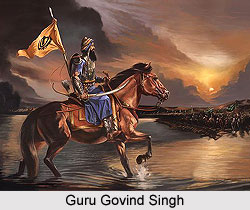 Banda Singh Bahadur became an ascetic after coming in contact with many sages and bairagis. He traveled far and wide but later settled down in a quiet village of Nanded situated on the bank of Godavari River. The most eventful incident that took place in Banda Bahadur`s life was his meeting with Guru Govind Singh. The incident took place during the months of September and October in 1708 AD.
Banda Singh Bahadur became an ascetic after coming in contact with many sages and bairagis. He traveled far and wide but later settled down in a quiet village of Nanded situated on the bank of Godavari River. The most eventful incident that took place in Banda Bahadur`s life was his meeting with Guru Govind Singh. The incident took place during the months of September and October in 1708 AD.
After Aurangzeb`s death in 1707, Prince Mauzzam or Bahadur Shah I was helped by Guru Gobind Singh during the battle of Jaijou in the war of succession. They were thus on good terms. The Guru had raised the issue of punishment to Wazir Khan of Sirhind for his atrocities on the Sikhs and his children. Bahadur Shah asked the Guru to accompany him to the south. The Guru went up to Nanded with the emperor. After a certain period of time he realized that the emperor was using delaying tactics and was not interested in any land of settlement. Guru Govind Sigh stayed back at Nanded and set up his own dera on the bank of Godavari River. Madho Das (Banda Bahadur) a bairagi then had also established a dera on the bank of river Godavari. He used to crack coarse jokes on sadhus visiting to his dera. They were made to sit on a particular couch and Madho Das would overturn the same with his occult powers and enjoyed the discomfiture of the visitors.
Meeting of Guru Govind Singh with Banda Bahadur
The Guru had heard about the bairagi`s activities and decided to meet him. So he went to the bairagi`s dera and seated himself on the very same magic couch. He also told his accompanying Sikhs to slaughter a couple of goats of the dera and prepare some food. Madho Das who was out nearby heard the news and became greatly disturbed. He came to his dera and tried all his occult powers to overturn the couch, but could not accomplish the same. Thus baffled, the poor and helpless Madho Das felt convinced of the superiority of his visitors. He fell at the Guru`s feet and sincerely apologized for the mistake. Thereafter he promised that henceforth he would serve the Guru as his slave (banda). It is since then that Madho Das has been named Banda Singh. The Guru was pleased with his humility pardoned him. He also found Banda suitable for his purpose and work. He was commissioned him to go to Punjab.
The Guru took Madho Das to his dera and explained to him the situation in Punjab. He also told him the means to handle the same. The Guru gave him five trusted followers and also letters to all his Sikh sangats asking them to assemble under his flag with an object of punishing Wazir Khan for murdering of the Sikhs. The Guru equipped him with his own bow and arrows, a flag of saffron colour, a battle drum, he deputed five of the Khalsa to accompany him and help with their counsel and advice. Banda Singh was to be the secular leader of the Sikhs. The Guru also gave him five arrows from his quiver and 25 soldiers. The Guru gave him the following instructions that he must follow throughout his life.
* Lead a life of Brahmcharya. Do not touch a woman.
* Speak the Truth.
* Serve and obey the Khalsa Panth.
* Do not establish a new sect.
* Be humble. Let not victory make you haughty and vain.
Having taken the Guru`s blessings, Banda, with a band of Sikhs, proceeded to the Punjab. He first attacked Sarhind where the Nawab had ordered the live burial of the two young sons of Guru Gobind Singh. Many villages were razed to the ground. The Muslim rulers caught fright and united together to ward off Banda Singh`s attacks. Wazir Khan, Governor of Sarhind, assisted by Khawaja Ali of Malerkotla, fought a decisive battle with Banda Singh`s forces in May 1710. The Muslims were defeated and Wazir Khan was killed in battle.









